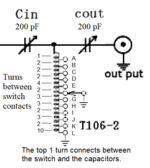George Alberta Canada
Newbie
How can I replace a 50pf - 190pf variable capacitor with a varactor circuit that can handle about 100 watts? Have been searching everywhere for a solution.
This is for a home made antenna tuna I am building. As it stands right now it can only work with a small amount of voltage/watts.
This is for a home made antenna tuna I am building. As it stands right now it can only work with a small amount of voltage/watts.
